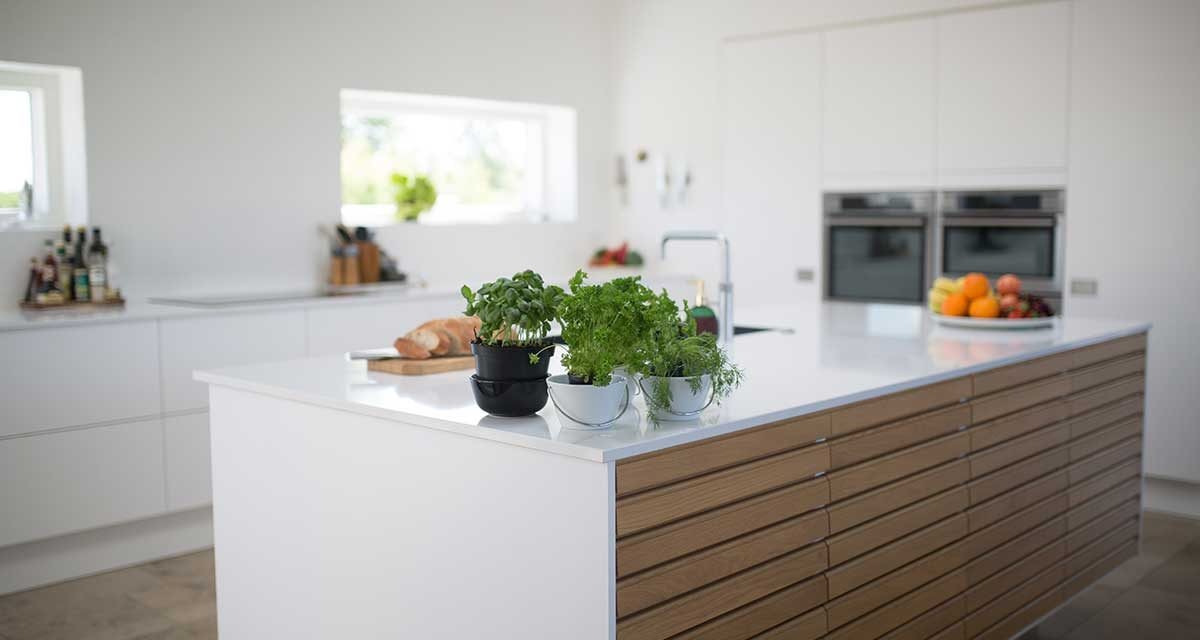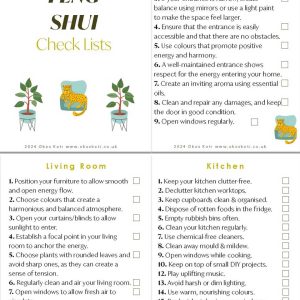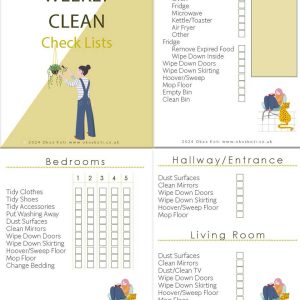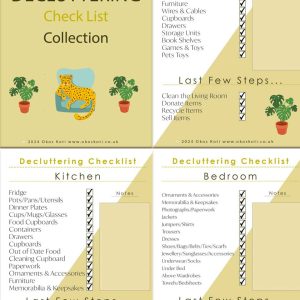How to Declutter and Organise Your Kitchen: A Step-by-Step Guide to Creating a Sustainable and Eco-Friendly Space
In today’s fast-paced world, the kitchen often serves as the heart of the home. It’s not just a place for preparing meals; it’s where family and friends gather, where conversations flow, and where memories are made. However, a cluttered and disorganised kitchen can quickly sap the joy out of this vital space. This comprehensive guide will walk you through a step-by-step process to declutter and organise your kitchen, transforming it into an efficient, sustainable, and eco-friendly haven for cooking, connecting, and embracing a greener lifestyle.
Section 1: Assess and Plan – Setting the Stage for a Successful Kitchen Declutter
Decluttering your kitchen is a transformative process that begins with careful assessment and thoughtful planning. In this section, we’ll delve into the crucial steps of evaluating your kitchen’s clutter and crafting a strategic plan to streamline your space efficiently.
Assess Your Kitchen’s Clutter
The first step in your journey to a clutter-free kitchen is to take a comprehensive look at current affairs. Stand in the centre of your kitchen and cast a critical eye over every nook and cranny. Pay close attention to:
· Overcrowded Cabinets: Open your kitchen cabinets and examine their contents. Are they crammed with dishes, cookware, and gadgets, making it hard to find what you need? Take note of any rarely used items that are taking up valuable space.
· Pantry Piles: Step into your pantry and assess the shelves. Are there expired items lurking in the back? Are non-perishable goods haphazardly stacked, making it challenging to access what you need?
· Countertop Chaos: Look at your countertops. Are they cluttered with appliances, utensils, and miscellaneous items? Are there items you rarely use taking up precious workspace?
· Under the Sink Surprises: Check beneath your sink. Are cleaning supplies jumbled together, making it challenging to find what you need? Are old, nearly empty bottles taking up space?
· Appliance Avalanche: Take a glance at your kitchen appliances. Are they neatly stored or scattered throughout the kitchen, contributing to a sense of chaos?
· Drawer Dilemmas: Open your drawers and assess their contents. Are they overflowing with utensils and gadgets? Are there items you’ve forgotten you even had?
Craft a Strategic Plan
Now that you’ve identified the areas of clutter in your kitchen, it’s time to craft a clear and achievable plan to tackle them effectively. Here’s how to go about it:
· Set Clear Objectives: Define your goals for decluttering and organising your kitchen. Ask yourself what you hope to achieve. Do you want to maximise space, enhance functionality, or create a more visually pleasing environment? Having well-defined objectives will serve as your guiding light throughout the process.
· Prioritise Areas: Prioritisation is vital to a successful decluttering journey. Decide which areas of your kitchen require immediate attention. Perhaps your pantry is the most cluttered, or your cabinets are overflowing. Starting with the most pressing areas can help you build momentum and motivation.
· Create a Timeline: Establish a realistic timeline for your decluttering project. Rome wasn’t built in a day, and neither will your perfectly organised kitchen. Be patient with yourself and allocate sufficient time for each phase of decluttering.
· Gather Necessary Supplies: Arm yourself with the right tools for the job. Collect bins, labels, cleaning supplies, and any other items you’ll need during decluttering. Opt for eco-friendly cleaning products to align with sustainability goals.
· Visualise the End Result: Envision how you want your kitchen to look and function after decluttering. This mental picture will keep you motivated and on track as you work towards your goal.
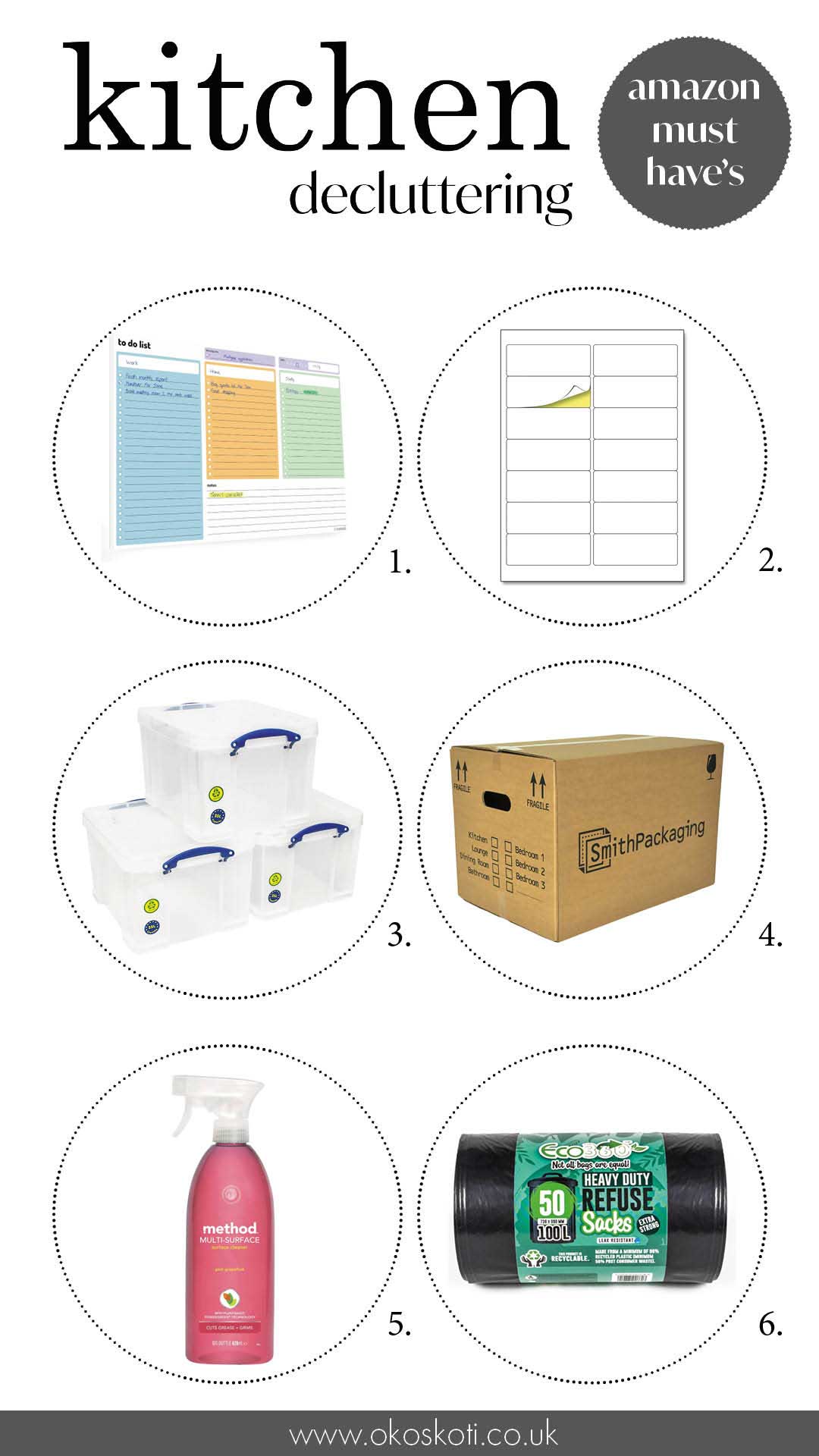

White Sticker Labels🌟Get Ready to Organise with a Smile! 😄✨ 14 Labels Per Sheet, 25 A4 White Sticker Labels – The Perfect Helpers for Keeping Your Stuff Shipshape and Organised! Let’s Turn Chaos into Cheerful Order! 🏷️🌟📦
Plastic Storage Boxes 🌟Unleash the Organisation Magic with the Really Useful Plastic Storage Box Bonus Pack!✨ You’ll Get a Fantastic Trio of 35-litre Clear Boxes – Three Times the Fun! These Boxes are Your Secret to Tidy Bliss! 📦💫 Get Ready to Declutter and Delight in a Neat and Cheerful Space!🏡🌈🧹
Heavy-Duty Eco-Friendly Refuse Sacks🌟 Go Green and Keep It Clean with 50 Heavy-Duty Eco-Friendly Refuse Sacks in Stylish Black! 🌱✨ You Get a Whole Bundle of Cleaning Convenience in One Package! Let’s Make Garbage Duty a Breeze! 🗑️🌈🌿
Toxin-Free Cleaner 🌟 Method Multi-Purpose Toxin-Free Cleaner in Pink Grapefruit! 🍊✨ It’s Not Just Cleaning – It’s a Burst of Citrusy Delight with a Side of Sparkle! Say Goodbye to Nasty Chemicals and Hello to Fresh, Clean Joy! 🌈🌟🧽
A4 To-Do List Pad 🌟 Your daily productivity powerhouse! With 52 sheets, a 3-section layout, and an undated format, it’s the ultimate desk organiser for home planning. Compact at 29x21cm, it’s stylish and efficient, helping you turn tasks into triumphs with flair!🌈🌟
10 Cardboard Boxes 🌟 Elevate your moving experience with SmithPackaging’s 10 Large, Strong Cardboard Packing Boxes! Measuring 51cm x 29cm x 29cm, these boxes are sturdy and spacious.
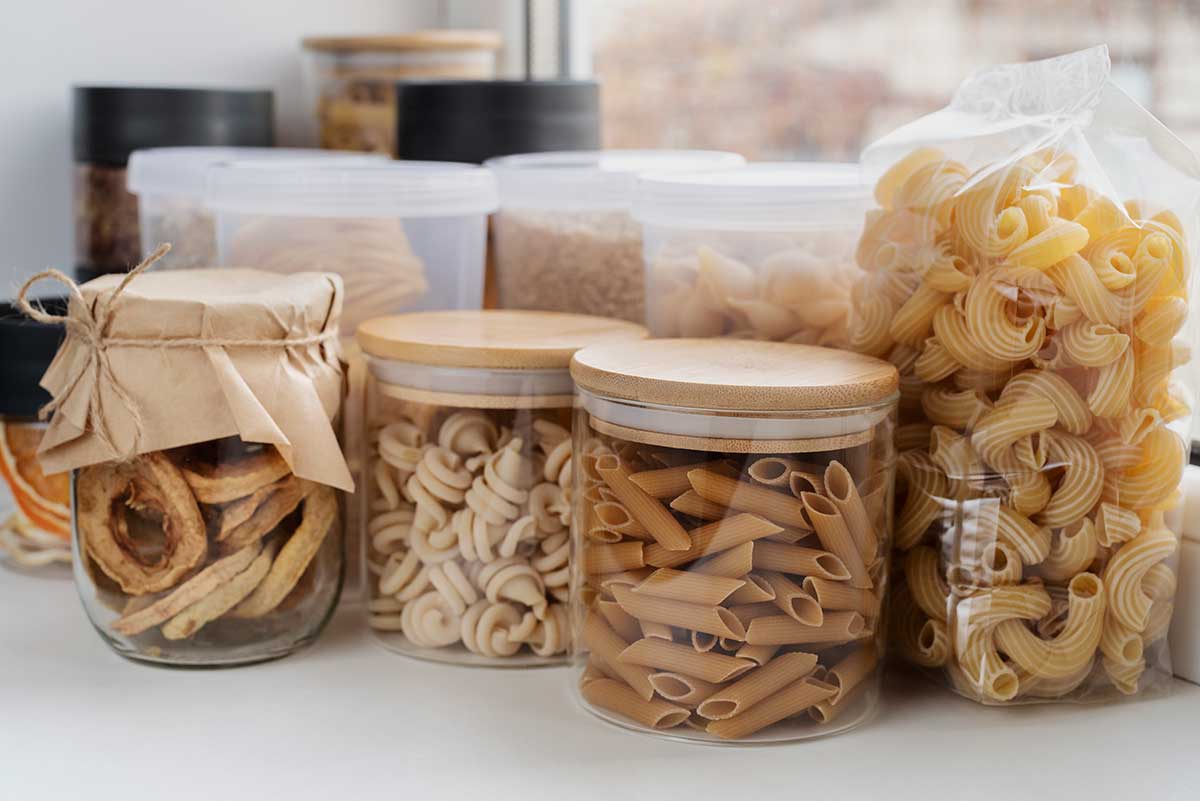
Section 2: Decluttering – The Art of Streamlining Your Kitchen
Now that you’ve meticulously planned your kitchen decluttering journey, it’s time to roll up your sleeves and embark on a systematic process of creating space, efficiency, and sustainability in your culinary haven. In this section, we’ll explore each facet of kitchen decluttering in detail, providing you with actionable steps to achieve a clutter-free and eco-friendly kitchen.
Start with the Pantry – A Fresh Start for Your Ingredients
Your pantry is often the first stop on your kitchen decluttering journey. This storage space houses a treasure trove of ingredients, and it’s crucial to keep it well-organised. Here’s how to tackle this area effectively:
- Expired Item Elimination: Begin by systematically going through every shelf and corner of your pantry. Identify and remove any expired or spoiled items. Dispose of them responsibly, ensuring they find their way into your compost bin or recycling.
- Donation Deliberation: If you come across non-perishable items that you know you won’t use, consider donating them to a local food bank or a charity organisation. This act not only reduces waste but also helps those in need.
- Airtight Awesomeness: To minimise food waste and maintain ingredient freshness, invest in airtight, reusable containers. Transfer grains, legumes, and other pantry staples into these containers. Not only does this reduce waste, but it also keeps your ingredients organised and readily accessible.
Tackle the Refrigerator and Freezer – The Chill Zone Transformation
Next on your kitchen decluttering journey is the refrigerator and freezer. These appliances are essential for keeping food fresh but can quickly become cluttered and disorganised. Follow these steps to bring order back to your chill zones:
- Empty and Assess: Start by emptying both your refrigerator and freezer compartments. As you do, check for any expired or spoiled items. Properly dispose of these items and wipe down the interior of both appliances.
- Organise for Accessibility: Group similar items together, placing them in designated sections within your refrigerator and freezer. By creating categories, you’ll make it easier to find what you need and reduce food waste.
- Glass Containers for Sustainability: Consider using glass containers instead of plastic for storing leftovers. Glass is eco-friendly and safer for food storage, as it doesn’t contain harmful chemicals found in some plastics.
Declutter Your Cabinets – The Cabinet Conundrum Resolution
Now, let’s turn our attention to your kitchen cabinets. Cabinets are like time capsules, holding onto items that rarely see the light of day. It’s time to free up space and create a more organised environment:
- Rarely Used Items Removal: Open each cabinet and carefully evaluate its contents. Identify dishes, utensils, or cookware that you rarely use. Are there duplicates or items you’ve outgrown? Donate or recycle these to declutter effectively.
- Repurposing Old Jars: Old glass jars can serve as excellent storage containers for items like dried herbs, spices, or grains. By repurposing jars, you reduce the need for additional plastic containers and promote sustainability.
Simplify Your Countertops – Embrace Minimalism for Efficiency
Countertop clutter can make your kitchen feel chaotic and cramped. To create an organised and serene workspace, follow these steps:
- Daily Essentials Only: Take a hard look at your countertops and assess which appliances and items you genuinely use on a daily basis. Store those within arm’s reach and put the rest away in cabinets or drawers.
Purge the Spice Rack – Spice Organisation with a Sustainable Twist
Spices and herbs are essential for adding flavour to your culinary creations. However, a cluttered spice rack can lead to disarray in your kitchen. Here’s how to spice things up in an eco-friendly way:
- Expiry Date Evaluation: Go through your spice collection and check for expiration dates. Discard any spices or herbs that have lost their potency or flavour.
- Eco-Friendly Spice Containers: Invest in eco-friendly spice containers made from materials like glass or stainless steel. These containers are sustainable and preserve the freshness of your spices for longer periods.
- Spice Rack Bliss: Consider a spice rack or organiser to keep your spices in perfect order. This makes it easier to access what you need while adding a touch of organisation and style to your kitchen.
Address the Junk Drawer – From Chaos to Clarity
The infamous junk drawer is a universal feature of many kitchens. While it often contains a mishmash of items, it’s possible to bring order to this space:
- Complete Emptying: Empty the contents of your junk drawer onto a clean surface. Sort through the items and assess their necessity. Keep what’s essential, and relocate other items to their proper homes or discard them responsibly.
- Drawer Dividers for Order: Invest in drawer dividers or organisers to maintain order in your junk drawer. These tools will keep items separated and easily accessible, preventing future chaos.
As you systematically declutter each aspect of your kitchen, you’ll begin to notice not only more physical space but also a sense of clarity and purpose in your culinary haven. In the following sections, we’ll delve into the organisational aspects of your kitchen, ensuring that every item has its designated place, promoting sustainability, and creating a space that embodies both functionality and eco-consciousness.
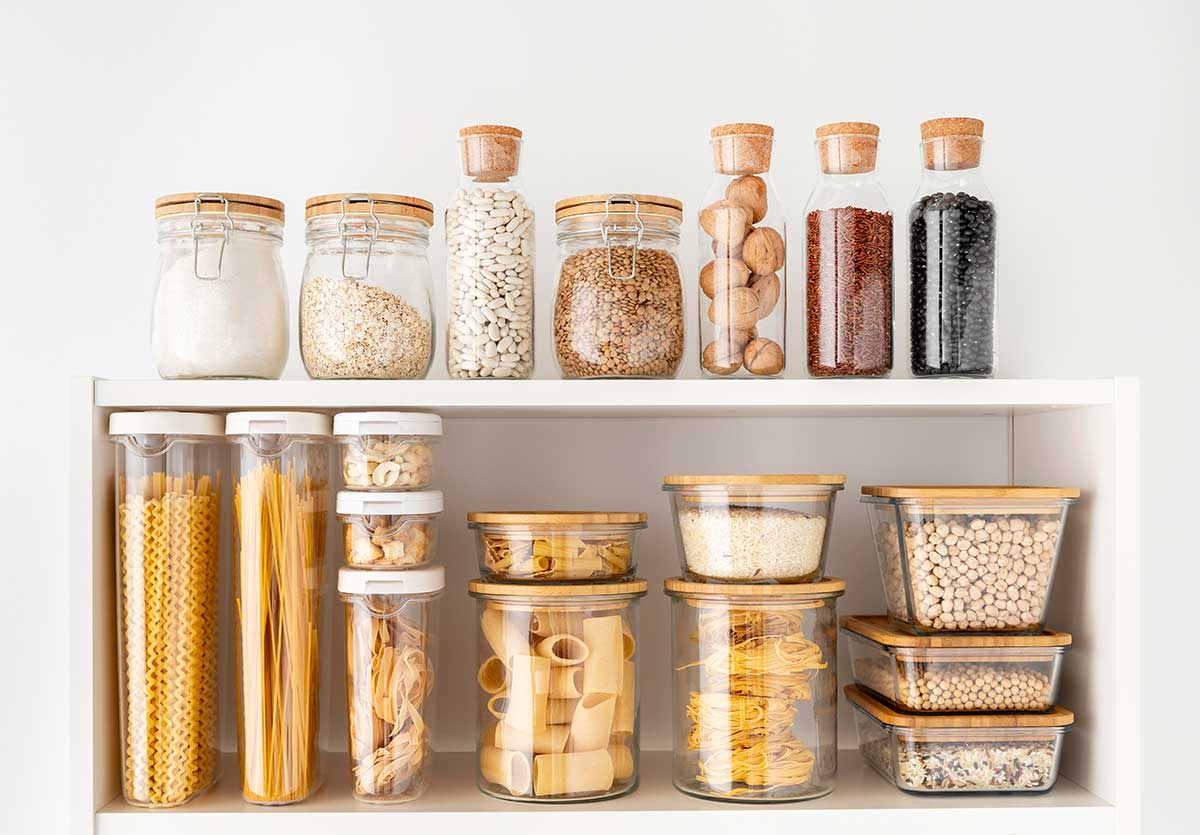
Section 3: Smart Kitchen Organisation – Streamlining Your Culinary Space
Efficiency and functionality go hand in hand in a well-organised kitchen. In this section, we’ll explore various strategies and tips for optimising your kitchen’s layout and organisation, ensuring that everything has its place and your space works seamlessly for you.
Zone Your Kitchen – Creating Efficiency Through Zones
To enhance the functionality of your kitchen, consider implementing zones for specific tasks. Here’s how to create a kitchen that operates like a well-oiled machine:
· Food Prep Zone: Designate an area for food preparation, ideally near your sink and cutting board. Keep essential tools like knives, cutting boards, and mixing bowls within arm’s reach. This setup streamlines the cooking process, making meal prep a breeze.
· Cooking Zone: Organise your pots, pans, and cooking utensils near your stove. Install pot racks or hooks to hang your cookware, freeing up cabinet space and ensuring easy access to the items you need while cooking.
· Cleaning Zone: Place your dish rack, dishwasher, and cleaning supplies near your sink. Having all these items within the same area makes cleanup more efficient, reducing post-mealtime stress.
· Baking Zone: If you enjoy baking, create a designated baking zone with easy access to your baking pans, measuring cups, and mixing bowls. This makes baking a more enjoyable and organised experience.
By implementing these zones, you’ll not only streamline your kitchen’s workflow but also reduce the need to move back and forth to gather necessary tools and ingredients.
Label Everything – The Art of Easy Identification
Labeling is a simple yet effective strategy to maintain a clutter-free and well-organised kitchen:
· Storage Containers: Label your storage containers to make it easy to identify the contents. This practice reduces the likelihood of food waste because you can quickly find what you need.
· Spice Jars: Label your spice jars clearly, indicating the name and expiry date of each spice or herb. This prevents you from using outdated or stale spices, ensuring your culinary creations are consistently delicious.
· Pantry Items: Labeling pantry items can help you quickly locate ingredients while cooking or baking. It also aids in meal planning and grocery shopping, as you can easily see what you have in stock.
Invest in Drawer Organisers – Neat and Tidy Drawers
Drawer organisers are essential tools for keeping your utensils, cutlery, and kitchen gadgets neatly arranged:
· Utensil Dividers: Use dividers in your utensil drawers to separate spoons, forks, knives, and other utensils. This prevents them from jumbling together and makes finding the specific utensil you need easy.
· Cutlery Trays: Invest in cutlery trays to systematically organise your knives, forks, and spoons. These trays can also have sections for serving utensils and other kitchen tools.
· Gadget Organisers: Consider organisers designed for kitchen gadgets and tools. These organisers keep your devices accessible while preventing clutter and chaos in your drawers.
Pot Racks and Hooks – Liberating Cabinet Space
Pots and pans can occupy significant cabinet space and become challenging to access. Here’s how pot racks and hooks can alleviate this issue:
· Pot Racks: Install a pot rack above your kitchen island or in a convenient location. Hanging your pots and pans not only frees up cabinet space but also adds a stylish, functional element to your kitchen decor.
· Hooks: Utilise hooks inside cabinet doors or on unused wall space to hang pots, pans, and cooking utensils. This strategy maximises storage potential and keeps your cookware easily accessible.
Utilise Vertical Space – Making the Most of Cabinets
Vertical space is underused in the kitchen. Here’s how to make the most of it:
· Shelves on Cabinet Doors: Install shelves or hooks on the backs of cabinet doors. This space can store small items like spices, measuring cups, or pot lids, freeing up cabinet space for other essentials.
· Floating Shelves: Consider adding floating shelves to your kitchen walls. These shelves can display decorative items, spices, or frequently used dishes, creating both storage and aesthetic appeal.
The Lazy Susan Trick – Easy Access to Hidden Items
Lazy Susans are rotating trays that can be used in both cabinets and the fridge. They’re a clever solution for accessing items tucked away in the back:
· Cabinet Lazy Susans: Use Lazy Susans in corner cabinets to access items at the back without rummaging. These can be particularly helpful for storing spices, condiments, or kitchen gadgets.
· Fridge Lazy Susans: In your refrigerator, Lazy Susans make it easier to reach items without moving everything around. They’re ideal for condiments, jars, or containers of frequently used ingredients.
By implementing these smart kitchen organisation strategies, you’ll create a space that looks and feels organised and functions seamlessly, making your culinary adventures pleasurable and contributing to a more eco-friendly and sustainable kitchen environment.
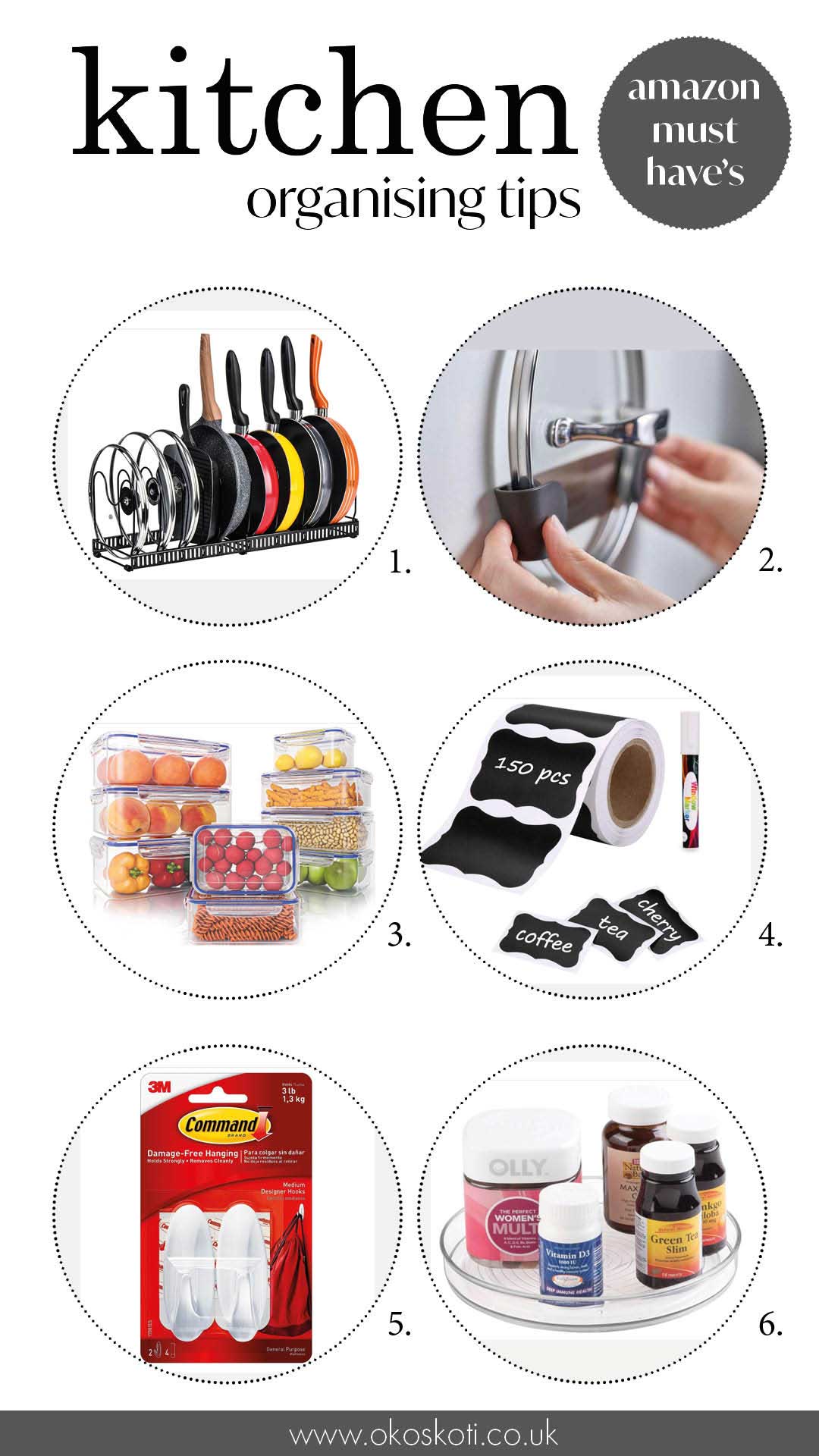


Toplife Expandable Pans Organiser Rack! 🌟 Turn Your Chaos into Kitchen Bliss with the Toplife Expandable Pans Organiser Rack! 🍳🎉 It’s Not Just a Rack – It’s Your Recipe for Pantry and Cupboard Happiness! With 10 Adjustable Compartments, It’s Perfect for Taming Your Bakeware, Lids, Plates, and More. Let’s Get Your Kitchen in Shipshape Order!🏡🌈✨

Joseph & Joseph Set of 4 Pot and Pan Lid Holders🌟Meet the Joseph Joseph Cupboard Store – Your Culinary Heroes for an Organised Kitchen! 🍳✨ This Fantastic Set of 4 Pot and Pan Lid Holders sticks right to Your Wall with Self-Adhesive Magic! Perfect for Lids Ranging from 16 cm to 24 cm, Included 3M VHB Tape for a Hassle-Free Setup. Let’s Make Your Kitchen the Coolest Place to Cook!” 🏡🌟🍽️

KICHLY Plastic Airtight Food Storage Containers!🌟Get Ready to Jazz Up Your Kitchen with the KICHLY Plastic Airtight Food Storage Containers! 🍽️ You’ll Receive a Fantastic Set of 18 Pieces – 9 Containers and 9 Matching Lids! These Containers Aren’t Just for Storage; They’re Your Recipe for a Leakproof, Organised, and Super Fun Kitchen! 🏡🌈

Joyoldelf Chalkboard Labels! 🌟Let’s Get Creative and Organised with Joyoldelf Chalkboard Labels! ✏️ This Awesome Kit Includes 150 Waterproof and Reusable Blackboard Stickers And a Handy White chalkpen. Let’s Add Some Fun to Your Space! 🏡🌈📦

Command Medium Designer Hooks! 🌟Upgrade Your Space with Command Medium Designer Hooks! You’ll Get a Fantastic Pack of 2 Hooks and 4 Adhesive Strips, All in Chic White! Say Goodbye to Messy Holes and Damage with These Damage-Free Hanging Wonders! They Hold up to 1.3kg 🌼🖼️

iDesign Lazy Susan Turntable Organiser! 🌟Get Ready to Spin and Win in Your Kitchen with the iDesign Lazy Susan Turntable Organizer! 🌪️This Little Marvel is the Perfect Rotating Spice Rack for All Your Food Storage Needs. Crafted from BPA-Free Plastic and Crystal Clear for Easy Visibility. Let’s Add Some Whirlwind Organisation to Your Culinary Adventures!🍽️🏡

Regular Check-Ups – Sustaining Your Decluttered Kitchen
While decluttering your kitchen is a significant achievement, it’s essential to maintain its organisation over time. Regular check-ups are your secret weapon to ensure your kitchen remains a clutter-free and functional space:
· Scheduled Inspections: Set aside time periodically, such as every few months, to inspect your kitchen’s organisation. Walk through each area and assess whether it still meets your needs and functions efficiently.
· Adjust as Needed: During these check-ups, don’t hesitate to make adjustments. Perhaps your cooking habits have evolved, or you’ve acquired new kitchen gadgets. Make changes to your organisation as necessary to keep your kitchen in sync with your lifestyle.
· Clutter Awareness: Use these check-ups as an opportunity to keep clutter at bay. If you notice items accumulating on your countertops or clutter sneaking into your cabinets, take action promptly. Return items to their designated spots or consider whether they’re still necessary.
· Maintenance Tasks: In addition to decluttering, use these check-ups to perform maintenance tasks. Clean out your refrigerator and pantry, wiping down shelves and checking for expired items. Test the efficiency of your organisational tools and replace anything that’s worn out or no longer serving its purpose.
Mindful Consumption – A Sustainable Kitchen Ethos
Creating an eco-friendly kitchen extends beyond decluttering and organisation. Mindful consumption plays a pivotal role in maintaining sustainability:
· Shopping Habits: Practice mindful shopping by buying only what you need. Create shopping lists and stick to them, avoiding impulse purchases that can lead to unnecessary clutter and waste.
· Minimal Packaging: Choose products with minimal packaging or eco-friendly packaging materials. This reduces the amount of waste entering your kitchen and, ultimately, the environment.
· Bulk Buying: Consider buying pantry staples in bulk. This reduces packaging waste and often saves you money in the long run. Store bulk items in airtight containers for freshness.
Repurpose and Upcycle – Reducing Waste Creatively
Embrace your creative side by repurposing and upcycling items in your kitchen. This not only reduces waste but also adds a touch of ingenuity to your space:
· Old Wooden Crates: Convert old wooden crates into shelves or storage units. Attach them to your kitchen wall to display decorative items, cookbooks, or spices.
· Mason Jars: Mason jars are incredibly versatile. Use them as stylish storage containers for dry goods, leftovers, or homemade condiments. They can also double as drinking glasses or vases for fresh flowers.
· Unused Furniture: If you have unused furniture, such as a small table or cabinet, consider repurposing it into a kitchen island or additional storage space. A fresh coat of paint or new hardware can breathe new life into old pieces.
Reduce Food Waste – A Green Kitchen Practice
Reducing food waste is not only good for your wallet but also for the environment. Here’s how to make this practice a cornerstone of your eco-friendly kitchen:
· Meal Planning: Plan your meals ahead of time to ensure you use ingredients before they go bad. This reduces the likelihood of food waste and encourages mindful consumption.
· Leftover Love: Embrace leftovers by incorporating them into future meals. Get creative with leftover ingredients to minimise waste.
· Freeze Excess: If you find yourself with excess food that you can’t use immediately, freeze it for later. Label and date items in your freezer to ensure you use them efficiently.
· Composting: Set up a composting system for kitchen scraps like fruit and vegetable peels, coffee grounds, and eggshells. Use the resulting compost to enrich your garden or indoor plants.
Eco-Friendly Kitchen Decor – Style with Sustainability
Sustainability doesn’t stop at decluttering and organisation; it extends to your kitchen decor choices:
· Bamboo Cutting Boards: Opt for cutting boards made from sustainable materials like bamboo. Bamboo is a fast-growing and renewable resource that’s perfect for kitchen use.
· Reusable Cloth Napkins: Replace disposable paper napkins with reusable cloth napkins. They add a touch of elegance to your dining experience while reducing paper waste.
· Natural Fiber Rugs: Consider natural fiber rugs for your kitchen floor. Materials like jute or sisal are biodegradable and environmentally friendly.
Creating an Eco-Friendly Culinary Haven – Sustaining the Dream
Following this step-by-step guide to decluttering and organising your kitchen, you’ll transform it into a functional and efficient space and contribute to a more sustainable and eco-friendly lifestyle. Embrace the principles of minimalism, sustainability, and mindful consumption to ensure your kitchen remains clutter-free and kind to the environment.
“As an Amazon Associate, I earn from qualifying purchases”
FAQ: Kitchen Decluttering Tips
Q1: How can I start decluttering my kitchen?
A1: To begin decluttering your kitchen effectively, start with one area at a time, such as the pantry or cabinets. Remove expired items, donate unused items, and consider transferring grains and legumes to airtight containers to reduce waste.
Q2: What are some eco-friendly kitchen decluttering tips?
A2: When decluttering your kitchen with sustainability in mind, focus on reducing waste. Use glass containers instead of plastic, set up a recycling station, and consider composting your kitchen waste. Also, choose energy-efficient appliances to minimise your carbon footprint.
Q3: How can I maintain an organised kitchen in the long run?
A3: Maintaining an organised kitchen requires regular upkeep. Periodically review your kitchen’s organisation to ensure it remains clutter-free and efficient. Practice mindful consumption by buying only what you need, repurposing items to reduce waste, and reducing food waste by planning meals and using leftovers creatively.
Q4: What are some smart kitchen organisation tips to complement decluttering?
A4: To enhance your kitchen’s functionality, create zones for specific tasks, label storage containers and pantry items, invest in drawer organisers, utilise pot racks and hooks to free up cabinet space, make use of vertical space with shelves or hooks on cabinet doors, and consider implementing Lazy Susans in cabinets and the fridge for easy access to items at the back.
Q5: How can I make my kitchen more sustainable with decluttering in mind?
A5: To make your kitchen more sustainable while decluttering, choose eco-friendly materials for shelving and storage, opt for reusable storage containers, compost kitchen waste, reduce energy consumption with energy-efficient appliances, and use eco-friendly cleaning products.

